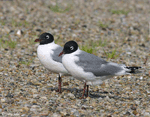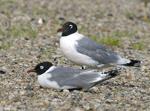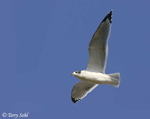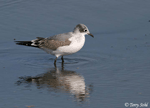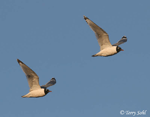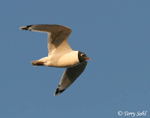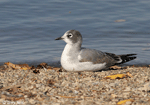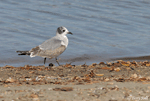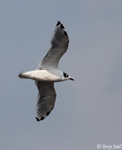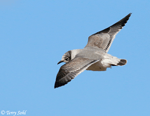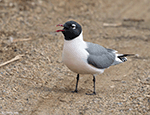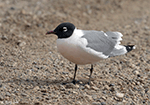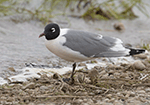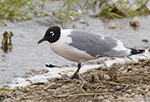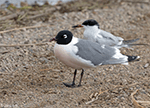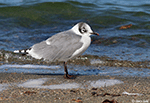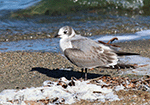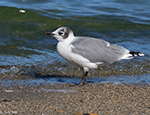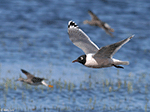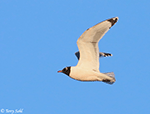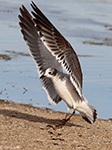| Length: 15 inches | Wingspan: 36 inches | Seasonality: Summer / Migrant |
| ID Keys: Black head (summer), gray upperparts, white underparts, wingtips with black bar | ||
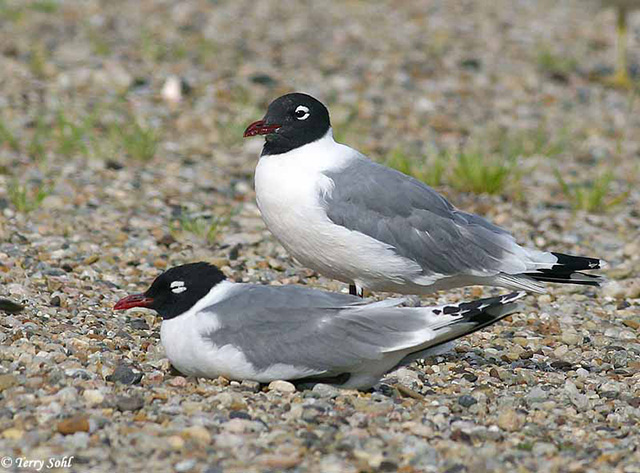 Franklin's
Gulls are a long-distance migrant, summering on the
northern Great Plains and central Canada, and wintering primarily in the
Southern Hemisphere along the western South America coast. In breeding
plumage they are a striking bird, with a black hood, white body, and gray wings,
with bold white eye arcs and very dark, ruddy red legs and bill. They are
breeding birds in South Dakota, although nesting locations may vary from year to
year given the often ephemeral or changing conditions of South Dakota's Prairie
Pothole wetlands. Commonly seen in migration as well, they can sometimes be seen
following plows in farm fields to pick off insects that have been stirred up. Compare to the
very similar Bonaparte's Gull which migrates
through the state, and also the Laughing Gull (rarely seen in South
Dakota).
Franklin's
Gulls are a long-distance migrant, summering on the
northern Great Plains and central Canada, and wintering primarily in the
Southern Hemisphere along the western South America coast. In breeding
plumage they are a striking bird, with a black hood, white body, and gray wings,
with bold white eye arcs and very dark, ruddy red legs and bill. They are
breeding birds in South Dakota, although nesting locations may vary from year to
year given the often ephemeral or changing conditions of South Dakota's Prairie
Pothole wetlands. Commonly seen in migration as well, they can sometimes be seen
following plows in farm fields to pick off insects that have been stirred up. Compare to the
very similar Bonaparte's Gull which migrates
through the state, and also the Laughing Gull (rarely seen in South
Dakota).
Habitat:
Nests around marshes, sloughs, and wetland vegetation around lake margins. Prefers large continuous areas of such habitat. Also seen feeding around farm fields, pastures and prairies, and flooded fields. On its wintering grounds, they are found near the coast on sandy beaches, estuaries, and shallow bays.
Diet:
Mostly insects in summer, also earthworms, crustaceans, mollusks, small fish, and some seeds.
Behavior:
Feeds in a variety of ways, from catching insects in flight, walking on the ground and picking up food items, swimming, or wading in shallow water.
Nesting:
May and June. Franklin's Gulls nest in colonies, often quite large (hundreds of pairs or more), and sometimes in association with other wetland species. Given their preference for nesting in areas with extensive cattail and other wetland vegetation, colony locations may change from year to year as ephemeral wetland conditions change over time. The nest itself is a floating platform of reeds and other vegetation, typically lined with finer grasses, hair, or down. While free-floating, the nest is anchored to adjacent vegetation such as cattails. Both parents help to build the nest, and both parents incubate the eggs, with the female typically laying 3. Incubation lasts about 24 days. The young fledge from the nest about 3 weeks after hatching, but typically stay in the vicinity of the nest and under protection of the parents for another week or two before taking flight.
Song:
A harsh cuk-cuk-cuk, with occasional interjected screaming keeah-ah keeah-ah.
- Click here to hear the flight call of a Franklin's Gull, recorded in Burke County, North Dakota1
- Click here to hear various calls from a flock of Franklin's Gulls, recorded in Burke County, North Dakota2
Migration:
Summers in northern Great Plains and central Canada. Winters along the Pacific Ocean in Central and South America.
Interactive eBird Map:
Click here to access an interactive eBird map of Franklin's Gull sightings
Similar Species:
There are other "black-hooded" gulls that the Franklin's Gull could potentially be confused with. Click here for identification tips for gulls in general, including Franklin's Gull. Here are the two species most likely to be confused with Franklin's Gull:
- Bonaparte's Gull - In South Dakota, the species most likely to be confused with a Franklin's Gull is the Bonaparte's Gull. These are the two common, "black-hooded" gulls that can be found in the state. In breeding plumage, both share similar body plumage and a dark hood, but the Bonaparte's Gull lacks the bold white eye arcs found on a breeding plumaged Franklin's Gull. Bonaparte's Gulls are also smaller overall, with a thinner, dark bill, while the bill of a breeding plumaged Franklin's Gull is typically a deep ruddy red. The legs of a Bonaparte's are orange, while those of a breeding plumaged Franklin's Gull are dark with reddish tones. In flight, the two can be distinguished by the upper wing pattern, with Bonaparte's Gulls having an obvious white triangle on the leading edge on the outside half of the upper wing, while Franklin's Gulls have a gray wing with black on the wingtips, ending in a white spot. For non-breeding birds, Bonaparte's Gulls have a distinctive dark "ear" spot with the rest of the head primarily white, while non-breeding Franklin's Gulls have more extensive black that remains from the black breeding "hood".
- Laughing Gull - Laughing Gulls are extremely rare visitors to South Dakota, as they are normally found along the eastern and Gulf coasts of the US. Where both are found, breeding plumaged birds are both very similar in appearance. Wingtips are the best identification feature, as Franklin's Gulls have black wingtips with white spots, while the wingtips on a Laughing Gull are almost entirely black. The bill of a Laughing Gull is also larger and more "jointed" looking than on a Franklin's Gull. They are perhaps more easily differentiated in flight, as breeding plumaged Laughing Gulls have rather extensive black on the primary flight feathers that's visible in flight, while Franklin's Gulls have mostly gray underwings, with black wingtips with white spots. For non-breeding birds, the head of a Laughing Gull is more consistently white, while the non-breeding Franklin's Gull still has quite a lot of smudgy black coloring.
- Black-headed Gull - Black-headed Gulls are extremely rare visitors to South Dakota as well. In good light, breeding plumaged Black-headed Gulls (ironically) have more of a dark bronwish tone to the head, whiel it's more of a pure black on a breeding plumaged Franklin's Gull. A identification key for both breeding and non-breeding plumaged birds are the dark primary feathers of a Black-headed Gull in flight, contrasting with a white leading edge on the wing. Franklin's Gulls have black just on the wing tip, with white spots.
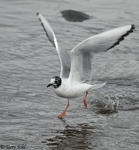 |
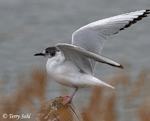 |
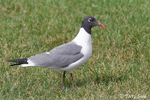 |
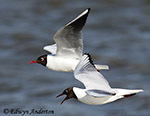 |
| Bonaparte's Gull | Bonaparte's Gull | Laughing Gull | Black-headed Gull |
Conservation Status:
Uncertain status in many areas, but overall, populations are strong, they are common in many parts of their range, and numbers overall are increasing. Habitat loss remains a local concern, but the overall population is not in danger, and the IUCN considers Franklin's Gull to be a species of "Least Concern".
Further Information:
Photo Information:
July 18th, 2004 -- Below Oahe Dam -- Terry Sohl
Additional Photos:
Click on the image chips or text links below for additional, higher-resolution Franklin's Gull photos.
Audio File Credits:
- 1Paul Marvin, XC282852. Accessible at www.xeno-canto.org/282852
- 2Andrew Spencer, XC104588. Accessible at www.xeno-canto.org/104588
| Click on the map below for a higher-resolution view |
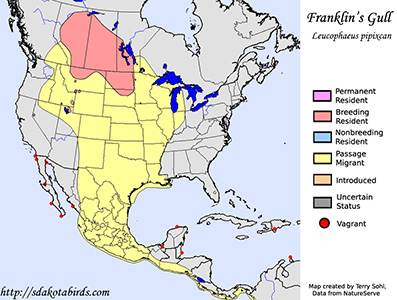 |
| South Dakota Status: Common migrant throughout the state. Common summer resident in parts of the northeastern part of the states. Uncommon summer visitor in other parts of the state. |
Additional Franklin's Gull Photos
Click for a higher-resolution version of these photos
